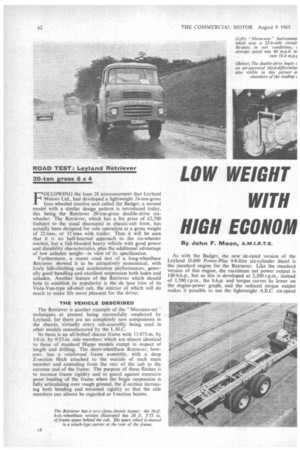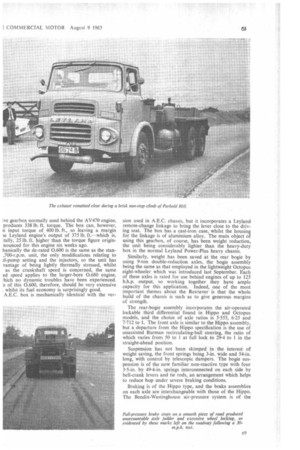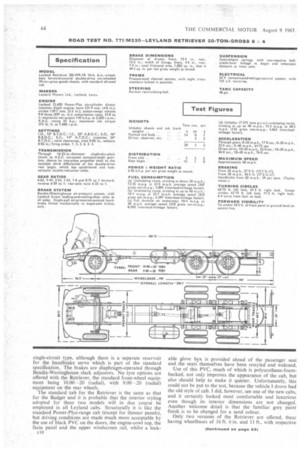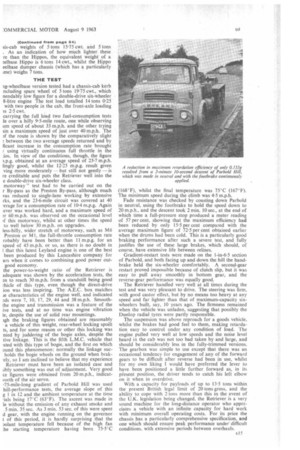LOW WEIGHT WITH HIGH ECONOM
Page 64

Page 65

Page 66

Page 71

If you've noticed an error in this article please click here to report it so we can fix it.
By John F. Moon, A.M.I.R.T.E. ROAD TEST: Leyland Retriever .20-ton gross 6 x 4 FOLLOWING the June 28 announcement that Leyland Motors Ltd., had developed a lightweight 24-ton-gross four-wheeled tractive unit called the Badger, a second model with a similar design pattern is introduced today, this being the Retriever 20-ton-gross double-drive sixwheeler. The Retriever, which has a list price of 0,700 (subject to the usual discounts) in chassis-cab form, has actually been designed for solo operation at a gross weight of 22 tons, or 32 tons with trailer. Thus it will be seen that it is no half-hearted approach to the six-wheeler market, but a full-blooded heavy vehicle with good power and durability characteristics, plus the additional advantage of low unladen weight—in view of its specification.
Furthermore, a recent road test of a long-wheelbase Retriever showed it to be attractively economical, with lively hill-climbing and acceleration performances, generally good handling and excellent suspension both laden and unladen. Another feature of the Retriever which should help to establish its popularity is the de luxe trim of its Vista-Vue-type all-steel cab, the interior of which will do much to make life more pleasant for the driver.
THE VEHICLE DESCRIBED The Retriever is another example of the " Meccano-set techniques at present being successfully employed by Leyland, for there are no completely new components in the chassis, virtually every sub-assembly being used in other models manufactured by the L.M.C.
Its basis is an all-bolted chassis frame with 11-875-in. by 3-0 in. by 0-25-in, side members which are almost identical to those of standard Hippo models except in respect of length and drilling. The short-wheelbase Retriever, however, has a reinforced frame assembly, with a deep Z.-section flitch attached to the outside of each main member and extending from the rear of the cab to the extreme end of the frame. The purpose of these flitches is to increase frame rigidity and to guard against excessive point loading of the frame when the bogie suspension is fully articulating over rough ground, the Z-section increasing both bending and torsional rigidity so that the side members can almost be regarded as I-section beams. As with the Badger, the new de-rated version of the Leyland 0.600 Power-Plus 9.8-litre six-cylinder diesel is the standard engine for the Retriever. Like the standard version of this engine, the maximum net power output is 140 b.h.p., but as this is developed at 2,200 r.p.m., instead of 1,700 r.p.m., the b.h.p. and torque curves lie lower on the engine-power graph, and the reduced torque output makes it possible to use the lightweight A.E.C. six-speed Lye gearbox normally used behind the AV470 engine, produces 338 lb. ft. torque. The box can, however, n input torque of 400 lb. ft., so leaving a margin le Leyland engine's output of 375 lb. ft.—which is, itally, 25 lb. ft. higher than the torque figure originflounced for this engine six weeks ago.
hanically the de-rated 0.600 is the same as the stan,700-r.p.in. unit, the only modifications relating to 2.1-pump setting and the injectors, so the unit has vantage of being lightly thermally stressed, whilst as the crankshaft speed is concerned, the same ed speed applies to the larger-bore 0.680 engine, rhich no dynamic troubles have been experienced. e of this 0.600, therefore, should be very extensive whilst its fuel economy is surprisingly good.
A.E.C. box is mechanically identical with the ver sion used in A.E.C. chassis, but it incorporates a Leyland remote-change linkage to bring the lever close to the driving seat. The box has a cast-iron case, whilst the housing for the linkage is of aluminium alloy. The main object of using this gearbox, of course, has been weight reduction, the unit being considerably lighter than the heavy-duty box in the normal Leyland Power-Pius heavy chassis.
Similarly, weight has been saved at the rear bogie by using 9-ton double-reduction axles, the bogie assembly being the same as that employed in the lightweight Octopus eight-wheeler which was introduced last September. Each of these axles is rated for use behind engines of up to 125 b.h.p. output, so working together they have ample capacity for this application. Indeed, one of the most important themes about the Retriever is that the whole build of the chassis is such as to give generous margins of strength.
The rear-bogie assembly incorporates the air-operated lockable third differential found in Hippo and Octopus models, and the choice of axle ratios is 5-555, 6-25 and 7-712 to I. The front axle is similar to the Hippo assembly, but a departure from the Hippo specification is the use of unassisted Burman recirculating-ball steering, the ratio of which varies from 50 to I at full lock to 29-4 to I in the straight-ahead position.
Suspension has not been skimped in the interest of weight saving, the front springs being 3-in, wide and 54-in. long, with control by telescopic dampers. The bogie suspension is of the now familiar non-reactive type with four 3.5-in. by 49-4-in, springs interconnected on each side by bell-crank levers and tie rods, an arrangement which helps to reduce hop under severe braking conditions.
Braking is of the Hippo type, and the brake assemblies on each axle are interchangeable with those of the Hippo. The Bendix-Westinghouse air-pressure system is of the single-circuit type, although there is a separate reservoir for the handbrake servo which is part of the standard specification. The brakes are diaphragm-operated through Bendix-Westinghouse slack adjustors. No tyre options are offered with the Retriever, the standard front-wheel equipment being 10.00-20 (radial), with 9.00 —20 (radial) equipment on the rear wheels.
The standard 'cab for the Retriever is the same as that for the Badger and it is probable that the interior styling adopted for these two models will in due course be employed in all Leyland cabs. Structurally it is like the standard Power-Plus-range cab (except for thinner panels), but driving conditions are made much more acceptable by the use of black PVC on the doors, the engine-cowl top, the facia panel and the upper windscreen rail, whilst a lock able glove box is provided ahead of the passenger seat and the seats themselves have been restyled and widened.
Use of this PVC, much of which is polyurethane-foambacked, not only improves the appearance of the cab, but also should help to make it quieter. Unfortunately, this could not be put to the test, because the vehicle 1 drove had the old style of cab. I did, however, see one of the new cabs, and it certainly looked most comfortable and luxurious even though its interior dimensions are not changed. Another welcome detail is that the familiar grey paint finish is to be changed for a sand colour.
Only two versions of the Retriever are offered, these having wheelbases of 16 ft. 6 in. and 11 ft., with respective sis-cab weights of 5 tons 15-75 cwt. and 5 tons . As an indication of how much lighter these re than the Hippos, the equivalent weight of a elbase Hippo is 6 tons 14 cwt., whilst the Hippo eelbase dumper chassis (which has a particularly me) weighs 7 tons.
THE TEST rig-wheelbase version tested had a chassis-cab kerb ncluding spare wheel of 5 tons 19.75 cwt., which nendably low figure for a double-drive six-wheeler 8-litre engine The test load totalled 14 tons 0.25 with two people in the cab, the front-axle loading is 2-5 cwt.
carrying the full load two fuel-consumption tests le over a hilly 9.5-mile route, one while observing urn speed of about 33 m.p.h, and the other trying sin a maximum speed of just over 40 m.p.h. The If the route is shown by the comparatively slight between the two average speeds returned and by ficant increase in the consumption rate brought r using virtually continuous full throttle in the ios. En view of the conditions, though, the figure i.p.g. obtained at an average speed of 25-7 m.p.h. lingly good, whilst the 12-25 m.p.g. result given
ving more moderately but still not gently -is re creditable and puts the Retriever well into the e double-drive six-wheeler class.
motorway" test had to be carried out on the r By-pass as the Preston By-pass, although much vas reduced to single-lane working by extensive rks, and the 23-6-mile circuit was covered at 40 'erne for a consumption rate of 10-4 m.p.g. Again ever was worked hard, and a maximum speed of 60 m.p.ht was observed on the occasional level this motorway, whilst at other times the speed to well below 30 m.p.h. on upgrades.
less-hilly, wider stretch of motorway, such as M6 Preston or Ml, the full-throttle consumption rate robably have been better than 11 m.p.g. for an speed of 45 m.p.h, or so, as there is no doubt in ! that this latest Leyland engine is one of the best been produced by this Lancashire company for ars when it comes to combining good power outgood economy. the power-to-weight ratio of the Retriever is adequate was shown by the acceleration tests, the E:n to reach 30 m.p.h. from a standstill being good :hick of this type, even though the direct-drive ion was less inspiring. The A.E.C. box matches se characteristics of the engine well, and indicated !ds were 7, 10, 17, 29, 44 and 58 m.p.h. Smooththe engine and transmission was a feature of the ive tests, and at no time was engine vibration le, despite the use of solid rear mountings. tgh the braking figures obtained are reasonably • a vehicle of this weight, rear-wheel locking spoilt ts, and for some reason or other this locking was Med by juddering of the bogie axles, despite the tive linkage. This is the fifth L.M.C. vehicle that :sted with this type of bogie, and the first on which aund this phenomenon: normally the linkage sueholds the bogie wheels on the ground when brakely, so I am inclined to believe that my experience Retriever must have been an isolated case and ibly something was out of adjustment. Very good lee figures were obtained from 20 m.p.h., indicatvorth of the air servo.
-75-mile-long gradient of Parbold Hill was used hill-performance tests, the average slope of this g I in 12 and the ambient temperature at the time ials being 17°C (63°F). The ascent was made in le without the emission of any exhaust smoke and 5 min. 35 sec. As 3 Mirk. 53 sec. of this were spent d gear, with the engine running on the governor t of this period, it is hardly surprising that the 3olant temperature fell because of the high fan he starting temperature having been 75-5'C
(168°F), whilst the final temperature was 75°C (167°F). The minimum speed during the climb was 4-5 m.p.h.
Fade resistance was checked by coasting down Parbold in neutral, using the footbrake to bold the speed down to 20 m.p.h., and the descent took 2 min. 10 sec., at the end of which time a full-pressure stop produced a meter reading of 57 per cent, showing that the maximum efficiency had been reduced by only 15-5 per cent compared with the average maximum figure of 7/5 per cent obtained earlier when the drums had been cold. This is a particularly good braking performance after such a severe test, and fully justifies the use of these large brakes, which should, of course, have extensive life between relines.
Gradient-restart tests were made on the l -in-6.5 section of Parbold, and both facing up and down the hill the handbrake held the six-wheeler comfortably. A second-gear restart proved impossible because of clutch slip, but it was easy to pull away smoothly in bottom gear, and the reverse-gear performance was equally good.
The Retriever handled very well at all times during the test and was very pleasant to drive. The steering was firm, with good castor effect, but by no means too heavy at any speed and far lighter than that of maximum-capacity sixwheelers built, say, 10 years ago. The firmness remained when the vehicle was unladen. suggesting that possibly the Dunlop radial tyres were partly responsible.
The suspension was above reproach for a goods vehicle, whilst the brakes had good feel to them, making retardation easy to control under any condition of load. The engine pulled very well at low speeds and the noise level heard in the cab was not too bad taken by and large, and should be considerably less in the fully-trimmed versions. The gearbox was simple to use except that there was an occasional tendency for engagement of any of the forward gears to be difficult after reverse had been in use, whilst for my own liking I would have preferred the lever to have been positioned a little further forward as, in its pfesent position, the driver tends to catch his left elbow on it when in overdrive.
With a capacity for payloads of up to 13.5 tons within the present British legal limit of 20 tons gross, and the ability to cope with 2 tons more than this in the event of the U.K. legislation being changed, the Retriever is a very sound machine for the long-distance operator who appreciates a vehicle with an infinite capacity for hard work with minimum overall operating costs. For its price the chassis has a particularly comprehensive specification, and one which should ensure peak performance under difficult conditions, with extensive periods between overhauls.
































































































































